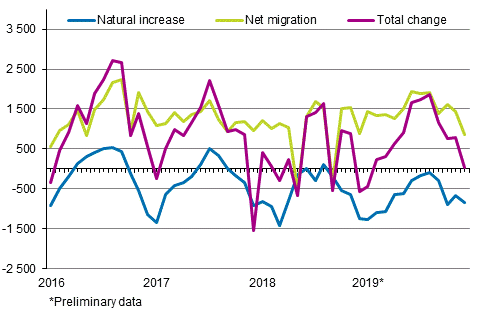Published: 23 January 2020
Decrease in birth rate still continues
Correction on 2 September 2020 . The correction is indicated in red.
According to Statistics Finland's preliminary data, Finland's population at the end of the year was 5,527,573. During 2019 Finland's population increased by 7,568 persons. The reason for the population increase was migration gain from abroad: the number of immigrants was 17,903 higher than that of emigrants. The number of births was 7,962 lower than that of deaths. The preliminary total fertility rate was the lowest in the measuring history, 1.35.
Population increase by month 2016–2019*

According to the preliminary statistics during 2019, a total of 45,597 children were born, which is 1,980 fewer than in the corresponding period 2018. Fewer children than this were last born in the hunger year 1868 and at the end of the 1830s. The number of deaths was 53,559 which is 968 lower than one year earlier.
Altogether 32,428 persons immigrated to Finland from abroad and 14,525 persons emigrated from Finland during 2018. The number of immigrants was 1,322 higher and the number of emigrants 4,616 lower than in the previous year. In all, 8,564 of the immigrants and 9,865 of the emigrants were Finnish citizens.
According to the preliminary data, the number of inter-municipal migrations totalled 284,150 by the end of the year. Compared with the previous year, the decrease was 4,293 migrations according to the municipal division of 2019.
Same-sex marriages took legal effect in March 2017. A total of 264 women and 118 men entered into marriage in which the spouse was of the same sex during 2019. In all, one female couple and one male couple changed their registered partnership into marriage.
According to preliminary data by region, the population grew only in Uusimaa, Pirkanmaa, Southwest Finland, North Ostrobothnia and Åland between January-September of 2019.
The population grew most in absolute numbers in Uusimaa, where it grew by 19,385 persons. The next largest increase in population was seen in Pirkanmaa, 2,725 persons. Relative to the population, population growth was highest in Uusimaa, 11.5 per mil, in Pirkanmaa, 5.3 per mil and in Åland, 3.8 per mil. Population loss was highest in absolute numbers in the region of South Savo that lost 2,235 persons of its population. The population of Kymenlaakso decreased by 2,079 persons, which was the second biggest population loss. Relative to the population, the biggest population loss was found in South Savo, 15.5 per mil.
Most migration gain from intramunicipal and international migration was collected by Uusimaa, 15,891 persons and Pirkanmaa, 3,150 persons. Most migration gain in relative terms based on total net migration was also attained by Uusimaa, 9.5 per mil and Pirkanmaa, 6.1 per mil.
In absolute numbers, migration loss from total net migration was biggest in the region of South Savo, 958persons. In the region of Kymenlaakso the loss was 883 persons. In relative terms, the biggest migration loss from total net migration was found in the region of South Savo, 6.7 per mil of the population.
During 2019, migration between regions numbered 132,042. The positive gain from migration between regions was seen in Uusimaa, Pirkanmaa and Southwest Finland. In absolute numbers, the highest gain from migration between regions was received by Uusimaa, 7,773 persons. The relative migration gain was highest in Uusimaa, 4.6 per mil of the population.
Migration loss from migration between regions was biggest in absolute numbers in the region of Kymenlaakso, 1,245 persons. Migration loss from migration between regions was biggest in relative terms in the region of South Savo, 8.7 per mil of the population.
Source: Preliminary population statistics, Statistics Finland
Inquiries: Juhana Nordberg 029 551 3051, Joonas Toivola 029 551 3355, Laura Lipasti 029 551 3041, info@stat.fi
Director in charge: Jari Tarkoma
Publication in pdf-format (256.5 kB)
- Tables
-
Tables in databases
Pick the data you need into tables, view the data as graphs, or download the data for your use.
Appendix tables
- Figures
-
- Appendix figure 1. Live births by quarter 1997 - 2018 and preliminary data 2019 (23.1.2020)
- Appendix figure 2. Deaths by quarter 1997 - 2018 and preliminary data 2019 (23.1.2020)
- Appendix figure 3. Intermunicipal migration by quarter 1997 - 2018 and preliminary data 2019 (23.1.2020)
- Appendix figure 4. Immigration by quarter 1997 - 2018 and preliminary data 2019 (23.1.2020)
- Appendix figure 5. Emigration by quarter 1997 - 2018 and preliminary data 2019 (23.1.2020)
Updated 23.01.2020
Official Statistics of Finland (OSF):
Preliminary population statistics [e-publication].
ISSN=2243-3627. December 2019. Helsinki: Statistics Finland [referred: 28.12.2025].
Access method: http://stat.fi/til/vamuu/2019/12/vamuu_2019_12_2020-01-23_tie_001_en.html

